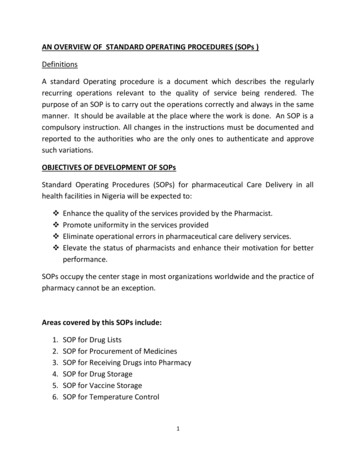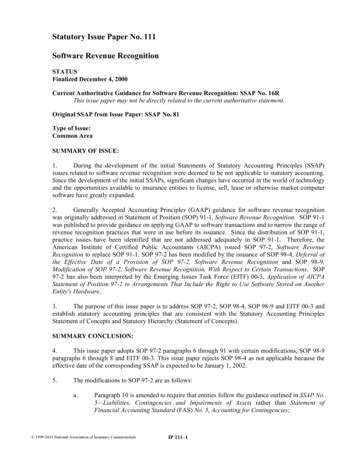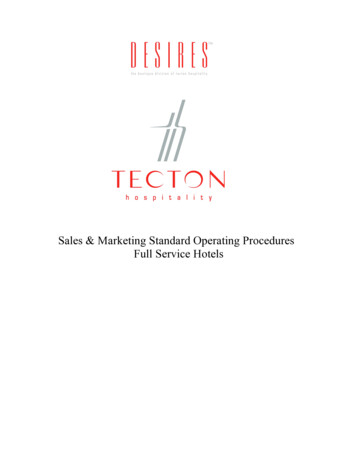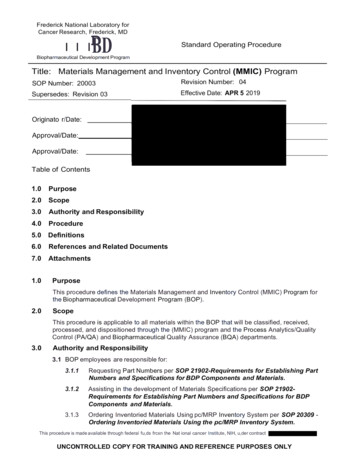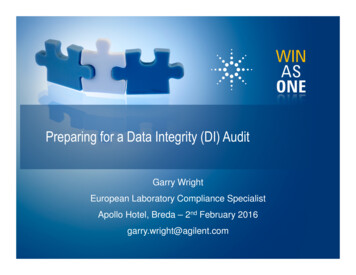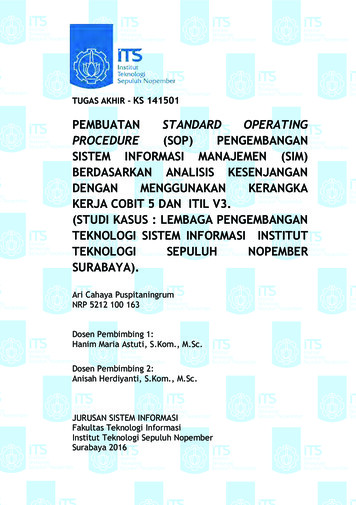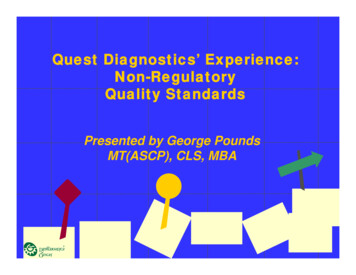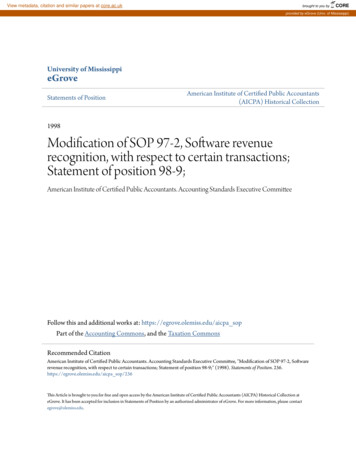
Transcription
View metadata, citation and similar papers at core.ac.ukbrought to you byCOREprovided by eGrove (Univ. of Mississippi)University of MississippieGroveStatements of PositionAmerican Institute of Certified Public Accountants(AICPA) Historical Collection1998Modification of SOP 97-2, Software revenuerecognition, with respect to certain transactions;Statement of position 98-9;American Institute of Certified Public Accountants. Accounting Standards Executive CommitteeFollow this and additional works at: https://egrove.olemiss.edu/aicpa sopPart of the Accounting Commons, and the Taxation CommonsRecommended CitationAmerican Institute of Certified Public Accountants. Accounting Standards Executive Committee, "Modification of SOP 97-2, Softwarerevenue recognition, with respect to certain transactions; Statement of position 98-9;" (1998). Statements of Position. 236.https://egrove.olemiss.edu/aicpa sop/236This Article is brought to you for free and open access by the American Institute of Certified Public Accountants (AICPA) Historical Collection ateGrove. It has been accepted for inclusion in Statements of Position by an authorized administrator of eGrove. For more information, please contactegrove@olemiss.edu.
STATEMENT O FPOSITION 9 8 - 9AMERICAN INSTITUTE OF CERTIFIED PUBLIC ACCOUNTANTSDecember 22, 1998Modification of SOP 97-2,Software Revenue Recognition,With Respect to CertainTransactionsIssued by theAccounting Standards Executive Committee
NOTEStatements of Position on accounting issues present theconclusions of at least two thirds of the Accounting Standards Executive Committee, which is the senior technicalbody of the Institute authorized to speak for the Institutein the areas of financial accounting and reporting. Statement on Auditing Standards No. 69, The Meaning of PresentFairly in Conformity With Generally Accepted AccountingPrinciples in the Independent Auditor's Report, identifiesAICPA Statements of Position that have been cleared bythe Financial Accounting Standards Board as sources ofestablished accounting principles in category b of thehierarchy of generally accepted accounting principlesthat it establishes. AICPA members should consider theaccounting principles in this Statement of Position if a different accounting treatment of a transaction or event is notspecified by a pronouncement covered by rule 203 of theAICPA Code of Professional Conduct. In such circumstances, the accounting treatment specified by the Statement of Position should be used, or the member should beprepared to justify a conclusion that another treatment betterpresents the substance of the transaction in the circumstances.Copyright 1998 byAmerican Institute of Certified Public Accountants, Inc.,New York, NY 10036-8775All rights reserved. For information about the procedure forrequesting permission to make copies of any part of this work,please call the AICPA Copyright Permissions Hotline at 201-938-3245.A Permissions Request Form for emailing requests is available atwww.aicpa.org by clicking on the copyright notice on any page.Otherwise, requests should be written and mailed to the PermissionsDepartment, AICPA, Harborside Financial Center, 201 Plaza Three,Jersey City, NJ 07311-3881.1234567890AccS 99 8
TABLE OF CONTENTSSummary4Foreword5Introduction and Background7Scope8Conclusions8Effective Date and Transition10Background Information and Basis for ConclusionsEffective Date and TransitionDue Process101617
SUMMARYThis Statement of Position (SOP) amends paragraphs 11and 12 of SOP 97-2, Software Revenue Recognition, to requirerecognition of revenue using the "residual method" when(1) there is vendor-specific objective evidence of the fairvalues of all undelivered elements in a multiple-elementarrangement that is not accounted for using long-term contract accounting, (2) vendor-specific objective evidence offair value does not exist for one or more of the delivered elements in the arrangement, and (3) all revenue-recognition criteria in SOP 97-2 other than the requirement forvendor-specific objective evidence of the fair value of eachdelivered element of the arrangement are satisfied. Underthe residual method, the arrangement fee is recognized asfollows: (1) the total fair value of the undelivered elements,as indicated by vendor-specific objective evidence, isdeferred and subsequently recognized in accordancewith the relevant sections of SOP 97-2, and (2) the difference between the total arrangement fee and theamount deferred for the undelivered elements is recognized as revenue related to the delivered elements.Effective December 15, 1998, this SOP amends SOP 98-4,Deferral of the Effective Date of a Provision of SOP 97-2,Software Revenue Recognition, to extend the deferral ofthe application of certain passages of SOP 97-2 provided bySOP 98-4 through fiscal years beginning on or beforeMarch 15, 1999. .All other provisions of this SOP are effective for transactions entered into in fiscal years beginning after March 15,1999. Earlier adoption is permitted as of the beginning offiscal years or interim periods for which financial statements or information have not been issued. Retroactive application of the provisions of this SOP is prohibited.4
FOREWORDThe accounting guidance contained in this document hasbeen cleared by the Financial Accounting Standards Board(FASB). The procedure for clearing accounting guidance indocuments issued by the Accounting Standards ExecutiveCommittee (AcSEC) involves the FASB reviewing and discussing in public board meetings (1) a prospectus for a project to develop a document, (2) a proposed exposure draftthat has been approved by at least ten of AcSEC's fifteenmembers, and (3) a proposed final document that has beenapproved by at least ten of AcSEC's fifteen members. Thedocument is cleared if at least five of the seven FASB members do not object to AcSEC undertaking the project, issuing the proposed exposure draft, or, after considering theinput received by AcSEC as a result of the issuance of theexposure draft, issuing a final document.The criteria applied by the FASB in their review of proposedprojects and proposed documents include the following.1. The proposal does not conflict with current or proposed accounting requirements, unless it is a limitedcircumstance, usually in specialized industry accounting, and the proposal adequately justifies the departure.2. The proposal will result in an improvement in practice.3. The AICPA demonstrates the need for the proposal.4. The benefits of the proposal are expected to exceedthe costs of applying it.In many situations, prior to clearance, the FASB will proposesuggestions, many of which are included in the documents.
Modification of SOP 97-2, SoftwareRevenue Recognition, With Respect toCertain TransactionsIntroduction and Background1.On October 27, 1997, the AICPA Accounting StandardsExecutive Committee (AcSEC) issued Statement of Position (SOP) 97-2, Software Revenue Recognition.2.Paragraph 10 of SOP 97-2 states that, if an arrangement includes multiple elements, the fee should be allocated to thevarious elements based on vendor-specific objective evidence of fair value. Vendor-specific objective evidence offair value is limited to the following:a. The price charged when the same element is soldseparatelyb. For an element not yet being sold separately, theprice established by management having the relevant authority (it must be probable that the price,once established, will not change before the separateintroduction of the element into the marketplace)3.Paragraph 12 of SOP 97-2 requires deferral of all revenuefrom multiple-element arrangements that are not accounted for using long-term contract accounting if sufficient vendor-specific objective evidence does not exist forthe allocation of revenue to the various elements of thearrangement.4.This SOP amends that guidance to require recognition ofrevenue in accordance with the "residual" method in thelimited circumstances described in paragraph 5 of this SOP.7
Scope5.This SOP applies only to multiple-element arrangements inwhich ( a ) a software element or other delivered element issold only in combination with one or more other elementsthat qualify for separate accounting pursuant to SOP 97-2,(6) vendor-specific objective evidence of fair value does notexist for one or more of the delivered elements, and ( c )there is vendor-specific objective evidence of the fair valueof each of the undelivered elements determined pursuantto paragraphs 10, 37, 57, and 66 of SOP 97-2.Conclusions6.The following changes are made to SOP 97-2.a. The following sentence is added to the end of paragraph 11 of SOP 97-2.Moreover, to the extent that a discount exists, theresidual method described in paragraph 12 [ofSOP 97-2] attributes that discount entirely to thedelivered elements.b. The following is added to the end of paragraph 12 ofSOP 97-2. 8There may be instances in which there is vendorspecific objective evidence of the fair values of allundelivered elements in an arrangement but vendor-specific objective evidence of fair value doesnot exist for one or more of the delivered elementsin the arrangement. In such instances, the feeshould be recognized using the residual method,provided that (a) all other applicable revenuerecognition criteria in this SOP [SOP 97-2] are metand (6) the fair value of all of the undelivered elements is less than the arrangement fee. Under theresidual method, the arrangement fee is recognizedas follows: (a) the total fair value of the undeliveredelements, as indicated by vendor-specific objectiveevidence, is deferred, and (b) the difference between the total arrangement fee and the amountdeferred for the undelivered elements is recognizedas revenue related to the delivered elements.
c. The following example is added to appendix A of SOP97-2, following "Multiple-Element Arrangements—Products and Services—Example 3."Multiple-Element Arrangements—Products andServices—Example 4FactsA vendor sells software product A for 950. The license arrangement for product A always includesone year of "free" PCS [postcontract customersupport]. The annual renewal price of PCS is 150.Revenue RecognitionAssuming that, apart from the lack of vendor-specific objective evidence of the fair value of the delivered software element, all applicable revenuerecognition criteria in this SOP [SOP 97-2] aremet, revenue in the amount of 150 should be deferred and recognized in income over the one-yearPCS service period. Revenue of 800 should be allocated to the software element and recognizedupon delivery of the software.DiscussionVendor-specific objective evidence of the fair valueof the software does not exist because the softwareis never sold separately. Consequently, sufficientvendor-specific objective evidence of fair valuedoes not exist for the allocation of revenue to thevarious elements based on their relative fair values. Paragraph 12 of this SOP [SOP 97-2] states,however, that the residual method should be usedwhen there is vendor-specific objective evidence ofthe fair values of all undelivered elements; allother applicable revenue recognition criteria inthis SOP [SOP 97-2] are met; and the fair value ofall of the undelivered elements is less than thetotal arrangement fee.If there had been vendor-specific objective evidenceof the fair value of the delivered software but not ofthe undelivered PCS, the entire arrangement feewould be deferred and recognized ratably over thecontractual PCS period in accordance with paragraphs 12 and 58 [of SOP 97-2].
7.Paragraph 5 of SOP 98-4, Deferral of the Effective Date of aProvision of SOP 97-2, Software Revenue Recognition, isreplaced with the following.The second sentences of paragraphs 10, 37, 41, and 57 ofSOP 97-2, which limit what is considered VSOE [vendorspecific objective evidence] of the fair value of the various elements in a multiple-element arrangement, andthe related examples noted in paragraph 3 of this SOP[SOP 98-4] need not be applied to transactions enteredinto before fiscal years beginning after March 15, 1999.8.All provisions of SOP 97-2 for software transactions outside the scope of this SOP and all other provisions of SOP97-2 for transactions within the scope of this SOP shouldbe applied as stated in SOP 97-2.Effective Date and Transition9.The provisions of this SOP that extend the deferral of the application of certain passages of SOP 97-2 are effective December 15, 1998. All other provisions of this SOP are effective fortransactions entered into in fiscal years beginning afterMarch 15, 1999. Earlier adoption is permitted as of the beginning of fiscal years or interim periods for which financialstatements or information have not been issued. Retroactiveapplication of the provisions of this SOP is prohibited.The provisions of this Statement need notbe applied to immaterial items.Background Information and Basis forConclusions10.SOP 97-2, Software Revenue Recognition, was issued onOctober 27, 1997, and became effective for transactionsentered into in fiscal years beginning after December 15,1997, with earlier application encouraged.11.Paragraph 10 of SOP 97-2 provides that, if a softwarearrangement includes multiple elements, the fee should be10
allocated to the various elements based on vendor-specificobjective evidence of fair value. Paragraph 12 of SOP 97-2provides that, if sufficient vendor-specific objective evidence of fair value does not exist for the allocation of revenue to the various elements of the arrangement, allrevenue from the arrangement should be deferred.12.Paragraph 10 of SOP 97-2 establishes only two conditionsthat constitute vendor-specific objective evidence of fairvalue. Neither of those conditions allows for the determination of the fair value of an element of a multiple-elementarrangement that is never sold separately. A consequenceof not having separate sales of one or more elements underSOP 97-2, as issued, is that all revenue from such anarrangement would be deferred in accordance with paragraph 12 of SOP 97-2.13.In developing the "unbundling" guidance in SOP 97-2,AcSEC deliberated the need for verifiable fair values ofeach of the elements. AcSEC did not support permitting allocation of the sales price of the package of elements to theindividual elements using differential measurement, inwhich an amount to allocate to an element for which thereis no separate vendor-specific objective evidence of fairvalue is inferred by reference to the fair values of elementsfor which there is vendor-specific objective evidence of fairvalue and the fair value of the total arrangement.1 AcSECwas concerned that, under differential measurement, anydifference between the fair values of the individual elements when sold separately and the fair value of the elements when sold as a package (that is, a discount) would beallocated entirely to undelivered elements, possibly resulting in a significant overstatement of reported revenue inthe period in which the software is delivered.14.In arriving at its conclusion in SOP 97-2, AcSEC did notdeliberate situations in which software or other deliveredelements would always be sold with one or more services or other undelivered elements that qualify for separate accounting. In such situations, there could bevendor-specific objective evidence of the fair value of the1. Differential measurement encompasses the residual method described in this SOP.
undelivered elements when sold separately (for example,by reference to renewal PCS or to the price for user training that is sold separately). Application of the conclusionsin paragraph 10 of SOP 97-2, however, would have resulted in a determination that there was not vendor-specific objective evidence of the fair value of the deliveredelement (for example, software). The provisions in paragraph 12 of SOP 97-2 would have required the initial deferral of all revenue from such arrangements.15.Subsequent to the issuance of SOP 97-2, some AcSECmembers came to believe that it is inappropriate to deferall revenue from the arrangement in such situations, because the use of the residual method would result in allocation of any discount entirely to the delivered element.Thus, there would be no potential for overstatement of revenue at the time of initial delivery of the software element.Indeed, it had been argued that recognizing no revenuefrom the delivered software element in such circumstanceswould inappropriately understate reported income.16.AcSEC considered this matter in light of paragraphs 95 and96 of Financial Accounting Standards Board (FASB) Statement of Financial Accounting Concepts No. 2, QualitativeCharacteristics of Accounting Information. Those paragraphs state the following.Conservatism no longer requires deferring recognition ofincome beyond the time that adequate evidence of itsexistence becomes available or justifies recognizinglosses before there is adequate evidence that they havebeen incurred.The Board emphasizes that any attempt to understateresults consistently is likely to raise questions about thereliability and the integrity of information about thoseresults and will probably be self-defeating in the longrun. That kind of reporting, however well-intentioned, isnot consistent with the desirable characteristics described in this Statement. On the other hand, the Boardalso emphasizes that imprudent reporting, such as maybe reflected, for example, in overly optimistic estimatesof realization, is certainly no less inconsistent with thosecharacteristics. Bias in estimating components of earnings, whether overly conservative or unconservative,12
usually influences the timing of earnings or losses ratherthan their aggregate amount. As a result, unjustified excesses in either direction may mislead one group of investors to the possible benefit or detriment of others.17.On February 11, 1998, AcSEC issued an exposure draft ofan SOP, Deferral of the Effective Date of Certain Provisionsof SOP 97-2, Software Revenue Recognition, for CertainTransactions. The exposure draft proposed deferring theeffective date of the provisions of paragraph 10 of SOP 972 with respect to what constitutes vendor-specific objectiveevidence of fair value of the software element in multipleelement arrangements in which—a. A software element is sold only in combination withPCS or other service elements that qualify for separate accounting pursuant to SOP 97-2, or both.b. There is vendor-specific objective evidence of thefair value of each of the service elements determinedpursuant to paragraphs 10, 57, and 65 of SOP 97-2.18.None of the commentators on that exposure draft objectedto deferral of the effective date of paragraph 10 of SOP 972 with respect to multiple-element arrangements withinthe scope proposed in the exposure draft. A significantnumber of commentators were concerned, however, aboutthe implications of restricting the scope to only certainmultiple-element arrangements, and they urged AcSEC tobroaden the scope to all multiple-element arrangements.19.As a result of AcSEC's deliberations of the comment letterson the February 11, 1998, exposure draft and examples ofarrangements brought to AcSEC's attention, AcSEC—a. Concluded that, for arrangements for which there issufficient vendor-specific objective evidence of thefair value of each element, even if each element isnot sold separately, the basis for deferral of revenuerecognition with respect to those elements that otherwise satisfied the criteria for revenue recognitionin SOP 97-2 needed to be reconsidered. Accordingly,AcSEC expanded the deferral to encompass all multiple-element software arrangements.
b. Affirmed the requirement in SOP 97-2 that any allocation of the fee in a multiple-element arrangement to thevarious elements should be based on fair values of eachelement and that such fair values must be supported byvendor-specific objective evidence, thus reinforcing theapplicability of that requirement to all arrangements.These conclusions were set forth in SOP 98-4, Deferral ofthe Effective Date of a Provision of SOP 97-2, SoftwareRevenue Recognition.20.On July 31, 1998, AcSEC issued an exposure draft of anSOP, Modification of the Limitations on Evidence of FairValue in Software Arrangements (A proposed amendmentto SOP 97-2, Software Revenue Recognition). That exposure draft proposed rescinding the second sentences ofparagraphs 10, 37, 41, and 57 of SOP 97-2. Further, the exposure draft proposed that vendor-specific objective evidence of the fair value of any one element of anarrangement could be inferred by reference to vendor-specific objective evidence of the fair value of the remainingelements in the arrangement and vendor-specific objectiveevidence of the fair value of the total arrangement. An example in the exposure draft suggested that such vendorspecific objective evidence of the fair value of the totalarrangement, which could differ from the arrangement fee,might be provided by sufficiently consistent pricing for thetotal arrangement in sales to other customers.21.Under AcSEC's July 31, 1998, proposal, any difference between the fair value of the total arrangement and thearrangement fee (the discount) for the particular transaction would be allocated to each element in the arrangementbased on each element's fair value without regard to the discount, in accordance with paragraph 11 of SOP 97-2.22. AcSEC received twenty comment letters on the exposuredraft. Although none of the commentators opposed modification of the evidentiary requirements of the second sentence of paragraph 10 of SOP 97-2, approximately half ofthe commentators requested further guidance on some aspect of what would constitute vendor-specific objective evidence of fair value and on some aspect of what mightconstitute "consistent pricing." Five respondents requested14
reconsideration of the acceptability of methods, perhaps inaddition to the exposure draft method, that would permitrecognition of a "minimum" amount of revenue when vendor-specific objective evidence of fair value does not exist foreach element in an arrangement or for the total arrangement.23.The Software Revenue Recognition Working Group, whichhad been advising AcSEC during this process, continued tosupport the position in the exposure draft. However,AcSEC was troubled by the significant number of commentletters requesting more guidance on the terms consistentpricing and vendor-specific objective evidence. In addition, certain comment letters explained that determiningvendor-specific objective evidence of fair value of totalarrangements is difficult because, in many cases, each salerepresents an independent negotiation. AcSEC believesthat, because of the wide variety of facts and circumstances that influence individual transactions, not all ofwhich can be anticipated, it cannot further define the termconsistent pricing without making arbitrary decisions anddrafting a multitude of rules. AcSEC believes that promulgating such specificity and arbitrary rules would be unwise.AcSEC was further troubled by the concept that therecould be a fair value for a multiple-element arrangementthat differs from the price paid for the total arrangement,which is negotiated between independent parties.24.AcSEC concluded, based on the information obtained during AcSEC's due process, that the approach proposed inthe July 31, 1998, exposure draft was not operational formultiple-element software arrangements. This conclusion,combined with concerns about the potential for a disproportionate allocation of any discount on an arrangement toundelivered elements (possibly resulting in an overstatement of revenue reported in the period of initial delivery ofthe software), caused AcSEC to conclude that it should retain the limitations on evidence of fair value in SOP 97-2.AcSEC did agree, however, to provide for the use of theresidual method in circumstances where there is vendorspecific objective evidence of the fair value of all the undelivered elements in an arrangement but there is notvendor-specific objective evidence of the fair value of oneor more delivered elements.
25. AcSEC notes that the residual method is not an acceptable alternative to allocation based on relative fair values when thereis vendor-specific objective evidence of the fair value of each element in a multiple-element arrangement. AcSEC acknowledges that the residual method represents an exception to therevenue-recognition model in SOP 97-2 that the arrangementfee should be allocated on the basis of relative fair values.AcSEC believes, however, that, in the particular circumstancesdiscussed in this SOP, recognition of some revenue for delivered elements is more appropriate than deferral of all revenue.Effective Date and Transition26. AcSEC initially agreed that this SOP should be effective fortransactions entered into in fiscal years beginning after December 15, 1998, the date on which the deferral of certainpassages of SOP 97-2 that is provided by SOP 98-4 wouldhave expired. However, several subsequent letters from thesoftware industry stated that some software companieswould have difficulty implementing this SOP (and the provisions of SOP 97-2 that had been deferred for one year bySOP 98-4) by that date. In response, AcSEC agreed tochange the effective date of this SOP to make it apply totransactions entered into in fiscal years beginning afterMarch 15, 1999. Moreover, in order to avoid the need fortwo accounting changes, AcSEC agreed to amend SOP 98-4to extend the deferral period through fiscal years beginningon or before March 15, 1999. AcSEC believes that this additional three-month period is sufficient to permit companies to implement both this SOP and the passages of SOP97-2 that had been deferred by SOP 98-4.27.The transition provisions of both SOP 97-2 and SOP 98-4are transaction based. It is, therefore, appropriate for thisSOP to be applied on a prospective basis to transactionsentered into in fiscal years beginning after March 15, 1999.28.The guidance that was deferred by SOP 98-4 was to have beenapplied prospectively. As this SOP reinstates the guidancein SOP 97-2 while adding one narrow exception, it is appropriate for this SOP to provide also for prospective application.29.Some entities may have adopted SOP 97-2 before its December 15, 1997, effective date and, upon the issuance of16
SOP 98-4, may have chosen not to restate their financialstatements to reflect the deferral of the application of thesecond sentences of paragraphs 10, 37, 41, and 57 of SOP97-2, as was permitted. Any differences in reported revenuepursuant to SOP 97-2 from the revenue that would havebeen reported under SOP 97-2 as amended by this SOP willreverse as the revenue recognition criteria are met for theundelivered elements of these arrangements. This is consistent with the transition methodology incorporated in SOP97-2. AcSEC believes that it is therefore unnecessary topermit retroactive application of this SOP by any entities.Due Process30.The exposure draft that preceded this SOP proposed rescinding the second sentences of paragraphs 10, 37, 41, and57 of SOP 97-2. Further, the exposure draft proposed thatvendor-specific objective evidence of the fair value of anyone element of an arrangement could be inferred by reference to vendor-specific objective evidence of the fair valueof the remaining elements in the arrangement and vendorspecific objective evidence of the fair value of the totalarrangement. An example in the exposure draft suggestedthat such vendor-specific objective evidence of the fairvalue of the total arrangement, which could differ from thearrangement fee, might be provided by sufficiently consistentpricing for the total arrangement in sales to other customers.31.The July 31, 1998, exposure draft did not propose the useof the residual method that is required by this SOP. However, the comment letters on the exposure draft clearlyidentified perceived weaknesses in the proposed approach.The comment letters also included recommendations toadopt the residual method in addition to the proposed approach that AcSEC ultimately rejected. Moreover, AcSECreceived and considered comments on the scope of theFebruary 11, 1998, exposure draft, which was similar tothe scope of this SOP. AcSEC concluded that it could reachan informed decision based on the comments received onthe two exposure drafts, without issuing a revised exposuredraft for public comment.
Accounting Standards Executive Committee(1998-1999)David B. Kaplan, ChairAlbert G. AdkinsMark M. BielsteinCassandra A. CampJoseph H. CappalongaJohn T. CiesielskiRobert O. DaleJoseph F. GrazianoRay L. KrauseLouis W. Matusiak, Jr.David M. MorrisBenjamin S. NeuhausenPaula C. PanikMark V. SeverMary StoneSoftware Revenue Recognition W o r k i n g G r o u pGeorge P. Fritz, ChairMichele AxelsonH. John DirksJerry MastersAICPA StaffElizabeth A. FenderDirectorAccounting StandardsFrederick GillSenior Technical ManagerAccounting Standards
www.aicpa.org014920
livered softwar elemente al, l applicabl revenue e recognition criteri ian this SOP [SOP 97-2 ar] e met, revenue in the amount o f 150 should be de-ferred and recognized in income over the one-year PCS service period. Revenue o f 800 should be al-located to the softwar elemene ant d recognized upon delivery of the software. Discussion
